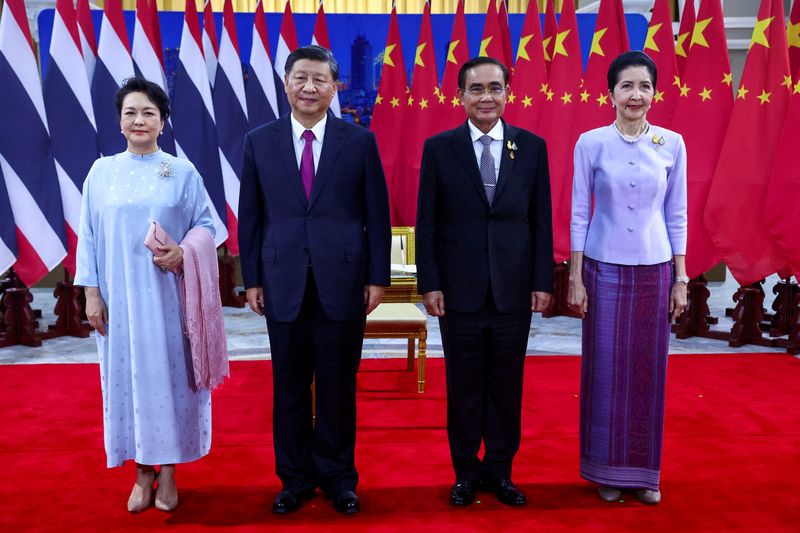Explainer-What is APEC? Asia-Pacific leaders head to San Francisco
2023.11.01 01:00

© Reuters. FILE PHOTO: Chinese President Xi Jinping and his wife Peng Liyuan stand for a group photo with Thai Prime Minister Prayuth Chan-ocha and his wife Naraporn Chao-ocha on the sidelines of the Asia-Pacific Economic Cooperation (APEC) summit in Bangkok, Thaila
By David Brunnstrom
WASHINGTON (Reuters) – Leaders from the 21-member Asia-Pacific Economic Cooperation forum will meet in San Francisco this month for the 30th APEC summit, the first hosted by the United States since 2011.
WHAT IS THIS YEAR’S LIKELY HIGHLIGHT?
Like most international gatherings, APEC has become a stage for strategic competition between the U.S. and China, the world’s two largest economies, and all eyes will be on an expected bilateral summit on the sidelines between U.S. President Joe Biden and Chinese President Xi Jinping.
Xi has yet to confirm his APEC attendance, but a meeting between the pair would be their second in person since Biden took office in January 2021. They first met at the G20 summit in Bali a year ago.
APEC leaders are due to gather between Nov. 15-17. From Nov. 11 senior APEC finance officials and ministers will meet ahead of the summit, while the annual APEC CEO summit will run from Nov. 14-16.
WHAT IS APEC?
APEC was founded in Canberra in 1989 as an informal dialogue forum to promote regional economic integration. It initially had 12 members. Now it has expanded to involve more than 100 meetings a year.
APEC membership covers 38% of the global population, or nearly 3 billion people, about 62% of GDP, and almost half of global trade.
APEC says it operates on the basis of non-binding commitments, open dialogue and equal respect for the views of all participants. Decisions are reached by consensus and commitments undertaken on a voluntary basis.
APEC’S MEMBERSHIP
APEC’s members are: Australia, Brunei, Canada, Chile, China, Hong Kong, Indonesia, Japan, South Korea, Malaysia, Mexico, New Zealand, Papua New Guinea, Peru, the Philippines, Russia, Singapore, Taiwan, Thailand, the United States and Vietnam.
It is unique in grouping member economies rather than nations, allowing participation of Chinese-ruled Hong Kong, as well as self-ruled Taiwan, which China claims as it own. It does not include India, however, the world’s most populous country.
Attempts by India to join APEC were stymied for decades – first because its economy was not integrated into the global system and then by a membership freeze.
Taiwan presidents do not attend APEC summits, but the island is represented either by senior former officials or business leaders, such as Morris Chang, founder of semiconductor maker TSMC who went to the Bangkok summit last year.
CURRENT CONTROVERSIES
Hong Kong’s representation has become controversial. Washington, as host, is in charge of the guest list and in July U.S. congressional aides told Reuters Hong Kong’s chief executive, John Lee, would not be invited as he is under U.S. human-rights sanctions.
The Hong Kong government said Lee would not attend due to “scheduling issues” and Financial Secretary Paul Chan would go to San Francisco instead.
Russia’s participation became divisive after it invaded Ukraine last year and its president, Vladimir Putin, did not attend the 2022 summit in Bangkok. The State Department has said Putin will not be in San Francisco.
Drafting a final summit declaration this year will be difficult due to divisions between members over conflicts in Ukraine and the Middle East.
In Bangkok last year leaders endorsed a text vowing to uphold and strengthen a rules-based multilateral trading system while noting “most” of them condemned Russia’s war in Ukraine.
Matt Goodman, a trade expert who was White House coordinator for the 2011 APEC summit, said smaller groups of like-minded states could issue their own statements.
“Given the make up of APEC with Russia and China both members, it’s more difficult than ever to really come up with some tangible outcomes,” he said.
BUZZWORDS
The U.S. has chosen the theme “Creating a Resilient and Sustainable Future for All” for APEC 2023. It says it aims for an “interconnected, innovative, and inclusive” region and “to advance a free, fair, and open economic policy agenda that benefits U.S. workers, businesses, and families. ”
As of 2021, APEC members made up seven of the United States’ top 10 overall trading partners.
Goodman expects the U.S. to highlight the relative strength of its economy in challenging times – a veiled comparison with difficulties China has faced after years of spectacular growth.
He said Washington would seek to highlight progress in the 14-nation Indo-Pacific Economic Framework (IPEF) it created to boost engagement after former President Donald Trump quit a regional trade pact in 2017.
FASHION SHOW
Traditionally APEC leaders wear local costume for a final-day group photo. This started in 1993 when President Bill Clinton prescribed bomber jackets in Seattle.
President Barack Obama, however, broke with tradition in 2011 by not ordering up the Hawaiian shirts that are de rigueur holiday attire on the islands. Whether and how San Francisco rises to the occasion remains to be seen.








